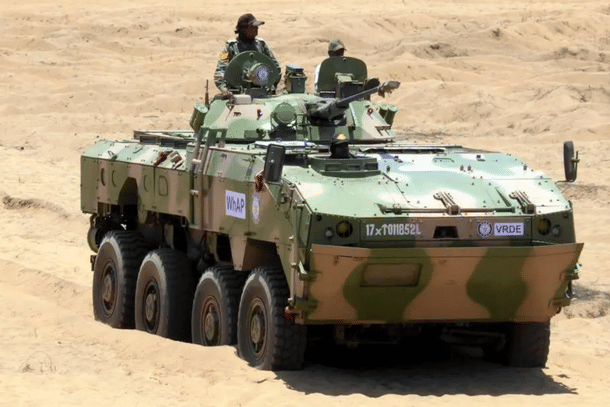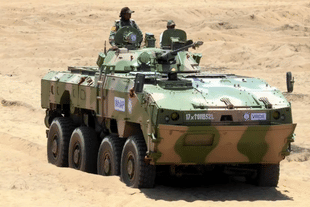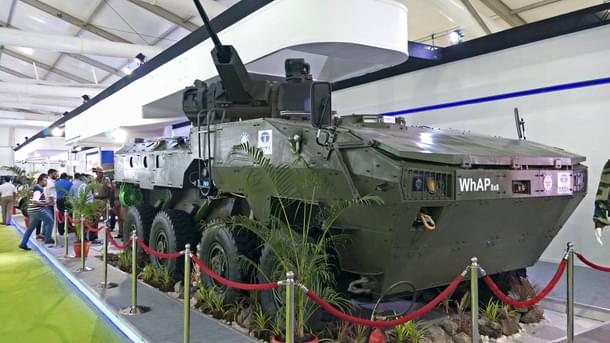Defence
Picking American Stryker Over India-Made WhAP Is A Setback To Atmanirbharta In Defence
Ujjwal Shrotryia
Jul 05, 2024, 07:02 PM | Updated 07:48 PM IST
Save & read from anywhere!
Bookmark stories for easy access on any device or the Swarajya app.


The Indian Army is reportedly ready to start trials of the Stryker Infantry Combat Vehicle (ICV), made in the United States (US).
The army is initially looking to procure around 530 Strykers, apparently to address the requirement of 10 wheeled battalions of the standard mechanised infantry battalions.
After an initial off-the-shelf purchase of a limited number of Stryker ICVs through the US government's foreign military sale programme, the remaining units will be manufactured in India.
These Strykers will be integrated with Javelin anti-tank guided missiles (ATGMs). Discussions are underway for joint production in India along with the transfer of technology.
As covered in Swarajya earlier, the decision to opt for Stryker ICVs is perplexing. It is an outright deviation from the Indian government's "atmanirbharta in defence" philosophy.
The Defence Research and Development Organisation (DRDO), in association with Tata, has already developed a wheeled armoured vehicle, or WhAP.
WhAP and Stryker are two different types of armoured vehicles, according to The Print, which reported on the Stryker trials, quoting sources. While WhAP is supposedly just an armoured personnel carrier (APC), the Stryker is an infantry combat vehicle (ICV).
Furthermore, WhAP reportedly does not offer firepower and lacks thermal sight and even a fire control system.
The Battle Of The Armoured Vehicles
APCs are vehicles primarily used as battle taxis to transport troops to the battlefield in relative safety.
They are not as heavily armoured as ICVs, can only withstand direct fire from small arms of up to 14.5 millimetre (mm) caliber, and have a machine gun for self-protection.
The ICVs, on the other hand, have a large 20-30 mm autocannon, are protected with thicker armour, and even have ATGMs. They can directly enter battle.
However, claiming that WhAP is just an APC is outright ridiculous.
WhAP, from the outset, is supposed to be a family of armoured carriers with several variants — a troop carrier, a command post variant, an ambulance, a chemical, biological, radiological, and nuclear (CBRN) variant, and an ICV variant carrying a remote turret with a 30 mm autocannon.
The ICV variant was displayed with a turret, carrying a 30 mm autocannon and panoramic thermal sights as well, at the Defexpo 2018.

Despite the availability of this variant, the Indian Army went with the troop carrier variant of the WhAP, known as the Infantry Protected Mobility Vehicle. It was inducted in Ladakh in 2022.
Why Stryker Over WhAP
Opting for the US-made Stryker despite the presence of WhAP's ICV variant disregards the years-long domestic effort of the scientists and engineers working at DRDO and Tata.
What's surprising is that the Stryker doesn't even fully fulfill the army's requirements. If the Stryker is finalised, its capabilities will have to be altered to suit high-altitude areas such as Eastern Ladakh, the report adds.
If that were the case, WhAP could have easily got the benefit of the doubt.
Surely, it cannot be the army's case that modifying and upgrading the Stryker, a foreign product, is easier than the India-made WhAP, whose entire intellectual property (IP) is within India, owned by DRDO and Tata.
If WhAP does not meet some of the qualitative requirements of the army, efforts could have been made through a collaboration with DRDO and Tata to bring it up to par.
Abandoning the vehicle for imported hardware, however, goes against the government policy of backing made in India products.
Quality Requirements That Can't Be Met
The army must consider how stringent are its quality requirements that no product in the world is able to meet them.
After all, no foreign vendor, not a single one from the 15 that replied to a request for proposal for acquiring ICVs, released a decade and a half ago by the army, were able to meet its quality requirements.
In February this year, the army came up with similar Marvel-comic-like quality requirements for next-generation tank, FRCV.
The army wanted the new tanks to weigh 55 tonnes, plus or minus 5 per cent, with a crew of four, while simultaneously having frontal armour of 800 mm RHA and a minimum of 600 mm RHA on all sides with blow-off panels. (Read about it on Swarajya here.)
Additionally, the army wanted all the bells and whistles, including an active protection system (APS) with 360 degrees and top attack protection against missiles, drones, and loitering munitions, jamming and electronic warfare solutions for soft-killing suicide drones, new-generation computers and electronics, the ability to control unmanned ground vehicles (UGV), and conduct manned-unmanned teaming (MUM-T) operations, all while having sufficient growth potential so that new technologies can be incorporated into the tank as they emerge.
Unfortunately, no tank in the world, whether the American M1A2 Abrams, the German Leopard 2, or the British Challenger, meets these requirements.
This happened back in 2011 too, when the army drafted quality requirements for Multi-Caliber Assault Rifles (MCAR) to replace the INSAS rifles. That project had failed spectacularly.
The army hoped its soldiers would be able to change the caliber of these rifles from 5.56 mm to 7.62 mm and vice versa by simply changing the barrels, a requirement no international vendor could meet.
It has been 13 years since that ill-fated proposal, and only late last year did the new rifle, the Russian AK-203, begin induction.
Introspection on the part of the army is necessary. It is now on the government of India to ensure that another world-class India-made equipment does not get sacrificed at the altar of imported hardware.
Staff Writer at Swarajya. Writes on Indian Military and Defence.





